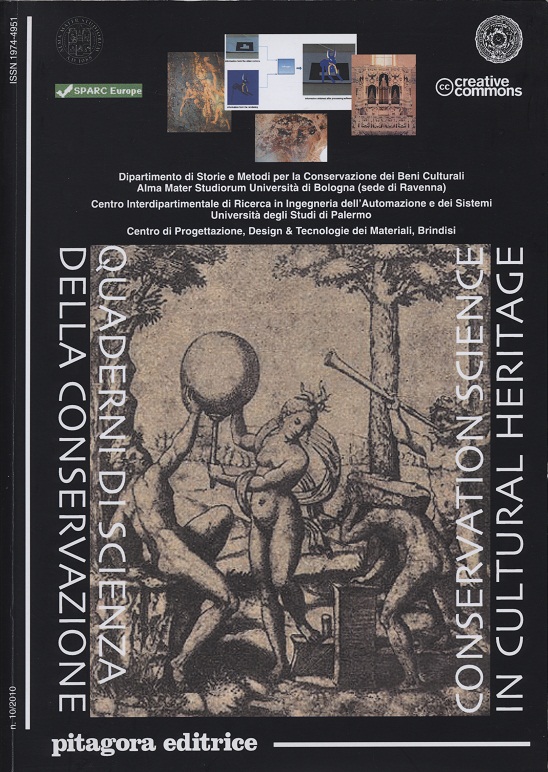Mineralogical and Spectroscopic Characterization of Some Products Resulting from the Weathering Process on the Tomb of Nakht-Djehuty (TT189), Western Thebes, Upper Egypt
DOI:
https://doi.org/10.6092/issn.1973-9494/2310Keywords:
wall paintings, western Thebes, weathering, crusts, dipinti murali, Tebe occidentale, agenti atmosferici, crosteAbstract
The present study deals with the mineralogical and spectroscopic characterization of some weathering products formed on the decorated surfaces of the tomb of Nakht-Djehuty (TT189), during the time of Ramesses II (the 19th Dynasty, c.1279-1213 BC), western Thebes, Upper Egypt. The wall paintings in the ancient tombs of western Thebes are subjected to salt weathering as a result of the geological structure of the Theban formation and the environmental conditions of the region which enhance the formation of several forms of damage. The weathering forms observed are mainly flakes, salt efflorescence, biofilms and hard crusts. Damaged layers have been collected and investigated using scanning electron microscopy equipped with energy dispersive X-ray analysis system (SEM-EDS), Powder X-ray diffraction analysis (PXRD) and Fourier transform spectroscopy (FTIR). The results showed that the main dominant salts affecting the site are sodium chloride (halite, NaCl) and phases of sulphates [gypsum, CaSO4 · 2H2O; bassanite, CaSO4 · 0.5H2O and anhydrite, CaSO4] were also detected. FTIR spectra collected on a KBr pellet of thin dark layers covering the decorated surfaces indicated the detection of calcium oxalate probably derived from biodegradation of the organic binders in tempera techniques or the organic coatings used in old restorations of the murals.
Riassunto
Il presente studio si propone di trattare la caratterizzazione mineralogica e spettroscopica di alcuni prodotti atmosferici formatisi sulle superfici decorate della tomba di Nakht-Djehuty (TT189), durante il regno di Ramesses II (la XIX Dinastia, c. 1279-1213 a.C.) nella Tebe occidentale, Alto Egitto. I dipinti murali nelle antiche tombe della Tebe occidentale sono soggetti all’azione del sale a causa della struttura geologica tebana e delle condizioni ambientali della regione, che favoriscono la formazione di diverse forme di degrado. Le azioni degli agenti atmosferici osservate sono principalmente distacchi, efflorescenze saline, biofilm e croste nere. Gli strati degradati sono stati raccolti e studiati attraverso l’utilizzo di: microscopio elettronio a scansione dotato di sistema ad analisi di dispersione di energia a raggi X (SEM-EDS), analisi diffrattometrica a raggi X di campioni in polvere (PXRD) e spettroscopia con trasformata di Fourier (FTIR). I risultati dimostrano che i sali dominanti che interessano il sito sono cloruro di sodio (salgemma, NaCl) e le diverse fasi dei solfati [gesso, CaSO4 · 2H2O; bassanite, CaSO4 · 0.5H2O e anidrite, CaSO4] che pure sono stati rilevati. Gli spettri FTIR dei sottili strati scuri che ricoprono le superfici decorate, raccolti su un pellet KBr, indicano l’individuazione di ossalati di calcio derivanti probabilmente dalla biodegradazione di leganti organici impiegati nella tecnica a tempera o di rivestimenti organici usati nei restauri antichi degli affreschi.
Résumé
L’étude présente se propose de traiter la caractérisation minéralogique et spectroscopique de certains produits atmosphériques qui se sont formés sur les surfaces décorées de la tombe de Nakhtdjehuty (TT189), durant le règne de Ramsès II (la XIXème Dynastie, c. 1279-1213 av. J.C.) dans la Thèbes occidentale, Haut Égypte. Les peintures murales dans les tombes antiques de la Thèbes occidentale sont sujettes à l’action du sel à cause de la structure géologique thébaine et des conditions environnementales de la région, qui favorisent la formation de différentes formes de dégradation. Les actions des agents atmosphériques observées sont principalement des détachements, des efflorescences salines, des biofilms et des croûtes noires. Les couches détériorées ont été récoltées et étudiées à travers l’utilisation de: microscope électronique à balayage doté d’un système à analyse de dispersion d’énergie à rayons X (SEM-EDS), analyse diffractométrique à rayons X d’échantillons en poudre (PXRD) et spectroscopie avec transformée de Fourier (FTIR). Les résultats démontrent que les sels dominants qui intéressent le site sont chlorure de sodium (sel gemme, NaCl) et les diverses phases des sulfates [gypse, CaSO4·2H2O; bassanite, CaSO4 · 0.5H2O et anhydrite, CaSO4] qui ont aussi été relevés. Les spectres FTIR des fines couches foncées qui recouvrent les surfaces décorées, recueillies sur un pellet KBr, indiquent la détermination d’oxalates de calcium dérivant probablement de la biodégradation de liants organiques employés dans la technique à tempera ou de revêtements organiques utilisés dans les restaurations antiques des fresques.
Zusammenfassung
Die vorliegende Untersuchung setzt sich zum Ziel, die mineralogische und spektroskopische Charakterisierung einiger atmosphärischer Produkte zu behandeln, die sich auf den verzierten Oberflächen des Grabs von Nacht-Djehuti (TT189) während der Regierung von Ramses II. (19. Dynastie, ca. 1279-1213 v.Chr.) im westlichen Theben in Oberägypten gebildet haben. Die Wandmalereien in den antiken Gräbern des westlichen Thebens sind wegen der geologischen Struktur Thebens und der Umweltbedingungen der Gegend, die die Bildung verschiedener Verwitterungsformen begünstigten, der Einwirkung von Salz ausgesetzt. Die beobachteten Wirkungen der atmosphärischen Einflüsse sind hauptsächlich Ablösungen, Salzausblühungen, Biofilme und schwarze Krusten. Die verwitterten Schichten wurden gesammelt und mit Hilfe folgender Verfahren untersucht: Rasterelektronenmikroskopie mit Energie- und Röntgendispersionssystem (SEM-EDS), röntgendiffraktometrische Analyse von Staubproben (PXRD) und Fourier-Transformationsspektroskopie (FTIR). Die Ergebnisse zeigen, dass die am Fundort vorherrschenden Salze Natriumchlorid (Steinsalz, NaCl) und die verschiedenen Sulfatphasen [Gips, CaSO4 · 2H2O; Bassanit, CaSO4 · 0.5H2O und Anhydrit, CaSO4] sind, die ebenfalls festgestellt wurden. Die FTIR-Spektren der feinen dunklen Schichten, die die verzierten Oberflächen bedecken, auf einem KBr-Pressling gesammelt, zeigen die Anwesenheit von Kalziumoxalaten, die wahrscheinlich aus dem biologischen Abbau organischer Leganten stammen, die bei der Temperatechnik benutzt wurden, oder organischer Beschichtungen, die zur antiken Restaurierung der Fresken eingesetzt wurden.
Resumen
El presente estudio se plantea la caracterización mineralógica y espectroscópica de algunos productos atmosféricos que se han formado sobre las superficies decoradas de la tumba de Nakht-Djehuty (TT189), durante el reinado de Ramesses II (la XIX Dinastía, c.1279-1213 a.C.) en la Tebas occidental, Alto Egipto. Las pinturas murales de las antiguas tumbas de la Tebas occidental están sujetas a la acción de la sal a causa de la estructura geológica de Tebas y las condiciones ambientales de la región, que favorecen la formación de distintas formas de deterioro. Las acciones de los agentes atmosféricos observados son principalmente efectos de desprendimiento, eflorescencias salinas, película biológica y corteza negra. Las capas degradadas se han recogido y estudiado utilizando: microscopio electrónico de barrido dotado con sistema de análisis de dispersión de energía de rayos X (SEM EDS), análisis difractométrico con rayos X de muestras en polvo (PXRD) y espectroscopía con transformada de Fourier (FTIR). los resultados demuestran que las sales dominantes que afectan al lugar son cloruro de sodio (sal gema, NaCl) y las distintas fases de los sulfatos [yeso, CaSO4 2H2O, basanita, CaSO4 0.5H2O y anhidrita, CaSO4] que también han sido detectadas. Los espectros FTIR de las sutiles capas oscuras que recubren las superficies decoradas, recogidas sobre un pellet KBr, indican la detección de oxalatos de calcio derivados probablemente de la biodegradación de ligantes orgánicos empleados en la técnica de témpera o de revestimientos orgánicos usados en las restauraciones antiguas de los frescos.
Downloads
Published
How to Cite
Issue
Section
License
Copyright (c) 2010 Hussein Hassan M.H. Mahmoud
Copyrights and publishing rights of all the texts on this journal belong to the respective authors without restrictions. Authors grant the journal right of first publication.
This journal is licensed under a Creative Commons Attribution 4.0 International License (full legal code).
See also our Open Access Policy.






